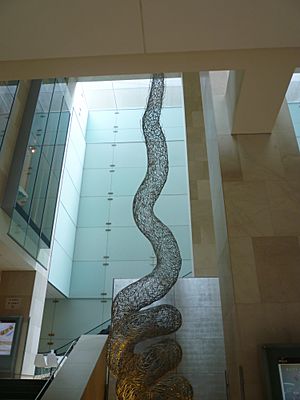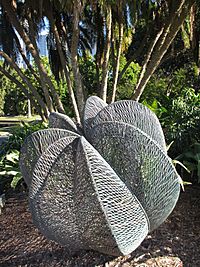Bronwyn Oliver facts for kids
Quick facts for kids
Bronwyn Oliver
|
|
|---|---|

"Vine" sculpture by Bronwyn Oliver
|
|
| Born |
Bronwyn Joy Gooda
22 February 1959 Gum Flat, New South Wales, Australia
|
| Died | 10 July 2006 (aged 47) |
| Nationality | Australian |
| Education |
|
| Known for | Sculpture |
|
Notable work
|
|
Bronwyn Joy Oliver (born Bronwyn Gooda, 22 February 1959 – 10 July 2006) was a famous Australian sculptor. She was best known for creating amazing artworks from metal. Bronwyn grew up in the countryside of New South Wales.
She studied art in Sydney and later in London. Bronwyn quickly became successful. She won a New South Wales Travelling Art Scholarship in 1981. She also won the Moet & Chandon Australian Art Fellowship in 1984. Bronwyn Oliver lived and worked in Sydney until she passed away in 2006.
People loved Oliver's sculptures because they felt interesting to touch. They also looked beautiful and showed great skill in how they were made. Later in her career, she mostly created art for public places or private collections. Some of her most famous works include Vine, a huge sculpture in the Sydney Hilton hotel. Others are Magnolia and Palm in the Sydney Botanical Gardens. You can also see Big Feathers in Brisbane's Queen Street Mall. Her art is kept in major Australian galleries. These include the National Gallery of Australia and the Art Gallery of New South Wales.
Contents
Bronwyn Oliver's Early Life
Bronwyn Gooda was born on 22 February 1959. Her hometown was Gum Flat, near Inverell in New South Wales. Her dad, Milton, was a farmer. Her mom, Wendy, worked in a pharmacy. Bronwyn's family encouraged her creativity from a young age.
When she was just eight, Bronwyn took art classes in Inverell. Her teacher, Ian Howard, later became a dean at her college in Sydney. Bronwyn was a top student at her school. Her parents hoped she would go to university. However, Bronwyn wanted to be an artist.
After school, Oliver moved to Sydney to study art. She planned to take painting classes. But a computer mistake put her in the sculpture course instead. She later said, "I knew straight away I was in the right place."
She finished her studies at the Alexander Mackie College of Advanced Education in 1980. In 1983, she won a scholarship to travel for art. This allowed her to get a master's degree at Chelsea School of Art in London in 1984. While in England, her work was inspired by artists like Richard Deacon and Antony Gormley. When she returned to Australia in 1984, she won another award. This was the Moet & Chandon Australian Art Fellowship. In 1988, she spent time as an artist-in-residence in Brest, France. There, she learned old Celtic metalworking skills.
About Bronwyn Oliver's Life
When she was in her early twenties, Bronwyn Gooda married Leslie Oliver. She took his last name and kept it. Bronwyn lived and had her art studio in Haberfield, a suburb in Sydney.
For 19 years, she taught art to young children. She taught at Cranbrook School in Sydney. Bronwyn was good friends with Roslyn Oxley. Roslyn owned a gallery where Oliver showed her artworks. Bronwyn's long-term partner was a wine writer named Huon Hooke.
Bronwyn Oliver's Artworks and Shows

One person who wrote about Bronwyn Oliver, Hannah Fink, guessed she made about 290 artworks. This was over 22 years of her career. Her public art pieces are her most famous sculptures.
These include Eyrie, made for the Hyatt Hotel in Adelaide in 1993. Also, Magnolia and Palm were made in 1999. They were for the Sydney Botanical Gardens' Sculpture Walk. In the same year, Big Feathers was made for the Queen Street Mall in Brisbane. It has two large feather shapes hanging above the walking area. They represent the mall's connection between earth and sky.
In 2000, Oliver's artwork Entwine was a finalist. It was in the first Helen Lempriere National Sculpture Award. The next year, Oliver won the University of New South Wales' first sculpture competition. Her winning piece was Globe, which was three meters high. More success followed. Her work Trace was chosen for the National Gallery of Australia's 2002 National Sculpture Prize exhibition.
By the 2000s, most of Oliver's work was made for special orders. These were for public places or private buyers. The biggest of these is Vine. It is a huge sculpture, 16.5 meters tall. It was put in the Sydney Hilton hotel after a big renovation. This sculpture took 12 months to make. It cost a lot of money and was finished in 2005. The sculpture was made from 380 kilograms of aluminum. A team of eight welders helped put it together.
By 2006, Oliver had held 18 solo art shows. Half of these were at Roslyn Oxley9 Gallery. This gallery showed her work throughout her career. Only one of her solo shows was outside Australia. This was in 1992 at the Auckland City Art Gallery. However, Oliver's art was shown in many international group exhibitions. These included shows in the United Kingdom and Japan in the 1980s. Later, her work was shown in Germany, East Asia, and the Beijing International Biennale in 2003.
How Bronwyn Oliver Made Her Art
Bronwyn Oliver was a sculptor for her whole art career. For her early works, she used materials like paper, cane, or fiberglass. But she found fiberglass to be dangerous and paper not lasting long enough. So, for most of her career, she worked with metal.
She used different metals for her art. The very large Vine sculpture was made from aluminum. The Brisbane sculpture Big Feathers was also aluminum. But most of her works, like Palm and Lock (2002), were made from copper. A book about her art from 1995 showed 25 works. All of them were made of copper. Some also used other materials like bronze or lead.
Oliver always thought about "what materials will do." She was interested in things built from the inside out. Her works often showed clues about how they were made. Friends and art critics noticed the marks and injuries she had. These came from working with such tough materials.
Oliver often started her ideas by sketching them. Then she would build them in 3D. For special orders, she used ideas from clients or the place where the art would go. For big works, she made small models. Sometimes these were made of plasticine. Other times, she used copper wire or wood and metal.
Oliver made the more delicate pieces herself. Many were made by shaping and joining wire to create abstract forms. She built these around molds. She twisted the metal with pliers and cut it with wirecutters. The pieces were joined by soldering or brazing. In her work Web (2002), she even sewed copper pieces together with wire.
Larger artworks were created at a special foundry. This was Crawfords Casting foundry in Enfield, Sydney. The foundry staff would make the parts of the sculptures. But Oliver would do the first steps. She also trained the staff and watched their work. Some parts were made using copper rods. Others were made using a technique called lost-wax casting. Each artwork could take up to two months to finish.
Bronwyn Oliver's Legacy
After Bronwyn Oliver passed away, her work continued to be recognized. Just before her death, she was chosen as a finalist for the 2006 Clemenger Contemporary Art Award. The next year, she was featured in a book called Untitled: Portraits of Australian Artists. In 2008, her final artworks were shown in the Adelaide Biennale of Australian Art.
Her sculptures also became very valuable. In 2007, her work Skein (2004) sold for $192,000 at an auction. By 2010, another of her sculptures, Tracery, was reported to have sold for $300,000. In 2011, the College of Fine Arts in Sydney named its new sculpture studio after her. In late 2017, a book about her life and art, Bronwyn Oliver: Strange Things, was released.
Works by Bronwyn Oliver are held in most major Australian art collections. These include the National Gallery of Australia, the Art Gallery of New South Wales, and the National Gallery of Victoria. Her art is also in the Queensland Art Gallery, the Art Gallery of South Australia, and the Auckland Art Gallery. In 2016 and 2017, a big exhibition of 50 of her key works was held. It showed her art from the mid-1980s to her last solo show in 2006.
See also
 In Spanish: Bronwyn Oliver para niños
In Spanish: Bronwyn Oliver para niños



